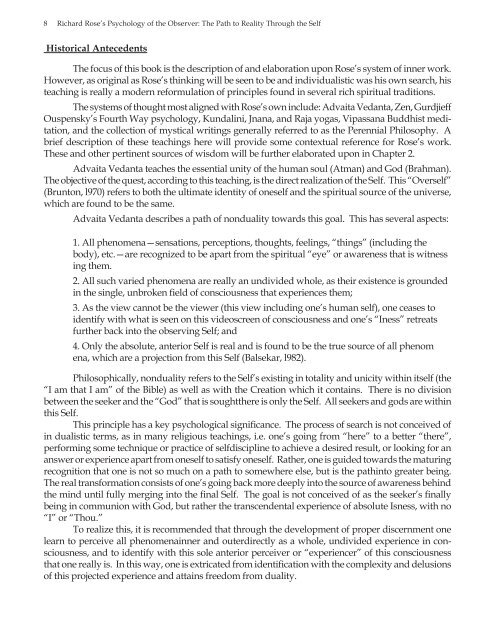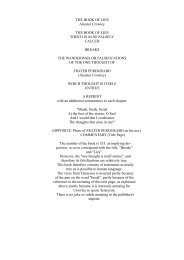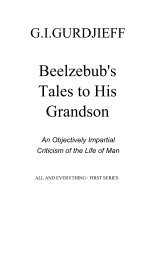Richard Rose’s Psychology of the Observer The Path to Reality Through the Self
John-Kent-Richard-Rose's-Psychology-of-Observer-Path-to-Reality-Thru-the-Self
John-Kent-Richard-Rose's-Psychology-of-Observer-Path-to-Reality-Thru-the-Self
You also want an ePaper? Increase the reach of your titles
YUMPU automatically turns print PDFs into web optimized ePapers that Google loves.
8 <strong>Richard</strong> <strong>Rose’s</strong> <strong>Psychology</strong> <strong>of</strong> <strong>the</strong> <strong>Observer</strong>: <strong>The</strong> <strong>Path</strong> <strong>to</strong> <strong>Reality</strong> <strong>Through</strong> <strong>the</strong> <strong>Self</strong><br />
His<strong>to</strong>rical Antecedents<br />
<strong>The</strong> focus <strong>of</strong> this book is <strong>the</strong> description <strong>of</strong> and elaboration upon <strong>Rose’s</strong> system <strong>of</strong> inner work.<br />
However, as original as <strong>Rose’s</strong> thinking will be seen <strong>to</strong> be and individualistic was his own search, his<br />
teaching is really a modern reformulation <strong>of</strong> principles found in several rich spiritual traditions.<br />
<strong>The</strong> systems <strong>of</strong> thought most aligned with <strong>Rose’s</strong> own include: Advaita Vedanta, Zen, Gurdjieff<br />
Ouspensky’s Fourth Way psychology, Kundalini, Jnana, and Raja yogas, Vipassana Buddhist meditation,<br />
and <strong>the</strong> collection <strong>of</strong> mystical writings generally referred <strong>to</strong> as <strong>the</strong> Perennial Philosophy. A<br />
brief description <strong>of</strong> <strong>the</strong>se teachings here will provide some contextual reference for <strong>Rose’s</strong> work.<br />
<strong>The</strong>se and o<strong>the</strong>r pertinent sources <strong>of</strong> wisdom will be fur<strong>the</strong>r elaborated upon in Chapter 2.<br />
Advaita Vedanta teaches <strong>the</strong> essential unity <strong>of</strong> <strong>the</strong> human soul (Atman) and God (Brahman).<br />
<strong>The</strong> objective <strong>of</strong> <strong>the</strong> quest, according <strong>to</strong> this teaching, is <strong>the</strong> direct realization <strong>of</strong> <strong>the</strong> <strong>Self</strong>. This “Overself”<br />
(Brun<strong>to</strong>n, l970) refers <strong>to</strong> both <strong>the</strong> ultimate identity <strong>of</strong> oneself and <strong>the</strong> spiritual source <strong>of</strong> <strong>the</strong> universe,<br />
which are found <strong>to</strong> be <strong>the</strong> same.<br />
Advaita Vedanta describes a path <strong>of</strong> nonduality <strong>to</strong>wards this goal. This has several aspects:<br />
1. All phenomena—sensations, perceptions, thoughts, feelings, “things” (including <strong>the</strong><br />
body), etc.—are recognized <strong>to</strong> be apart from <strong>the</strong> spiritual “eye” or awareness that is witness<br />
ing <strong>the</strong>m.<br />
2. All such varied phenomena are really an undivided whole, as <strong>the</strong>ir existence is grounded<br />
in <strong>the</strong> single, unbroken field <strong>of</strong> consciousness that experiences <strong>the</strong>m;<br />
3. As <strong>the</strong> view cannot be <strong>the</strong> viewer (this view including one’s human self), one ceases <strong>to</strong><br />
identify with what is seen on this videoscreen <strong>of</strong> consciousness and one’s “Iness” retreats<br />
fur<strong>the</strong>r back in<strong>to</strong> <strong>the</strong> observing <strong>Self</strong>; and<br />
4. Only <strong>the</strong> absolute, anterior <strong>Self</strong> is real and is found <strong>to</strong> be <strong>the</strong> true source <strong>of</strong> all phenom<br />
ena, which are a projection from this <strong>Self</strong> (Balsekar, l982).<br />
Philosophically, nonduality refers <strong>to</strong> <strong>the</strong> <strong>Self</strong>’s existing in <strong>to</strong>tality and unicity within itself (<strong>the</strong><br />
“I am that I am” <strong>of</strong> <strong>the</strong> Bible) as well as with <strong>the</strong> Creation which it contains. <strong>The</strong>re is no division<br />
between <strong>the</strong> seeker and <strong>the</strong> “God” that is sought<strong>the</strong>re is only <strong>the</strong> <strong>Self</strong>. All seekers and gods are within<br />
this <strong>Self</strong>.<br />
This principle has a key psychological significance. <strong>The</strong> process <strong>of</strong> search is not conceived <strong>of</strong><br />
in dualistic terms, as in many religious teachings, i.e. one’s going from “here” <strong>to</strong> a better “<strong>the</strong>re”,<br />
performing some technique or practice <strong>of</strong> selfdiscipline <strong>to</strong> achieve a desired result, or looking for an<br />
answer or experience apart from oneself <strong>to</strong> satisfy oneself. Ra<strong>the</strong>r, one is guided <strong>to</strong>wards <strong>the</strong> maturing<br />
recognition that one is not so much on a path <strong>to</strong> somewhere else, but is <strong>the</strong> pathin<strong>to</strong> greater being.<br />
<strong>The</strong> real transformation consists <strong>of</strong> one’s going back more deeply in<strong>to</strong> <strong>the</strong> source <strong>of</strong> awareness behind<br />
<strong>the</strong> mind until fully merging in<strong>to</strong> <strong>the</strong> final <strong>Self</strong>. <strong>The</strong> goal is not conceived <strong>of</strong> as <strong>the</strong> seeker’s finally<br />
being in communion with God, but ra<strong>the</strong>r <strong>the</strong> transcendental experience <strong>of</strong> absolute Isness, with no<br />
“I” or “Thou.”<br />
To realize this, it is recommended that through <strong>the</strong> development <strong>of</strong> proper discernment one<br />
learn <strong>to</strong> perceive all phenomenainner and outerdirectly as a whole, undivided experience in consciousness,<br />
and <strong>to</strong> identify with this sole anterior perceiver or “experiencer” <strong>of</strong> this consciousness<br />
that one really is. In this way, one is extricated from identification with <strong>the</strong> complexity and delusions<br />
<strong>of</strong> this projected experience and attains freedom from duality.




